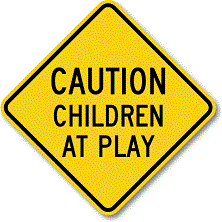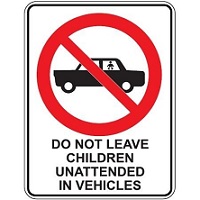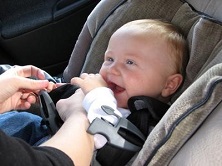|
page 9 of 11
Child Endangerment
Checking Around the Vehicle Prior to Entering or Leaving
 It is recommended to follow these safety rules to avoid child-related injuries or other vehicle dangers:
Never leave a child alone in or around a vehicle.
Check to make sure all children leave the vehicle when you reach your destination, particularly when loading and unloading. Don’t overlook sleeping infants.
Place a reminder of your child’s presence where you’ll be sure to see it before leaving the vehicle (diaper bag next to your briefcase, baby blanket under your lunch, etc.)
Never leave a child in a vehicle with the motor running or the key in the ignition. Children, while at play, may release the brake or shift gears to neutral, thus endangering themselves and everyone around them.
Keep car keys away from children at all times.
Always lock your car, even at home, and remind your friends and neighbors to do the same.
Teach children not to play in, on or around cars.
Keep rear fold-down seats closed to help prevent children from getting into the trunk from inside the car.
Make sure all heavy objects are properly secured in a vehicle to avoid getting harmed at the time of a collision or sudden stops.
It is recommended to follow these safety rules to avoid child-related injuries or other vehicle dangers:
Never leave a child alone in or around a vehicle.
Check to make sure all children leave the vehicle when you reach your destination, particularly when loading and unloading. Don’t overlook sleeping infants.
Place a reminder of your child’s presence where you’ll be sure to see it before leaving the vehicle (diaper bag next to your briefcase, baby blanket under your lunch, etc.)
Never leave a child in a vehicle with the motor running or the key in the ignition. Children, while at play, may release the brake or shift gears to neutral, thus endangering themselves and everyone around them.
Keep car keys away from children at all times.
Always lock your car, even at home, and remind your friends and neighbors to do the same.
Teach children not to play in, on or around cars.
Keep rear fold-down seats closed to help prevent children from getting into the trunk from inside the car.
Make sure all heavy objects are properly secured in a vehicle to avoid getting harmed at the time of a collision or sudden stops.
Unattended Children

In the fall of 2001 the governor of California signed into law Senate Bill 255, also known as Kaitlyn’s Law. Named for Kaitlyn Russell, a six-month-old who died after being left alone in a parked car for more than two hours, the law makes it illegal for a child to be left unattended in a motor vehicle. This law prohibits leaving a child of age 6 or younger in a motor vehicle if the engine is running, if the keys are in the ignition, or if there are other "risk" conditions, unless there is a person 12 years of age or older in the vehicle. A parent, legal guardian, or other person responsible for a child unattended in a motor vehicle would be punishable by a fine of $100.
On a warm day, the temperature inside a parked car can reach as high as 140s in as little as two hours. A young child’s body temperature will rise three to five times faster than an adult’s will, resulting in serious injury or death. The U.S. Department of Transportation’s National Highway Traffic Safety Administration (NHTSA) and the National SAFE KIDS Campaign work throughout the year to remind parents and childcare providers of the dangers of leaving children unattended in motor vehicles.
Properly Securing Children
 A parent or legal guardian, when present in a motor vehicle, may not permit his or her child to be transported upon a highway in the motor vehicle without properly securing the child in a rear seat in a child passenger restraint system meeting applicable federal motor vehicle safety standards, unless the child is one of the following:
A parent or legal guardian, when present in a motor vehicle, may not permit his or her child to be transported upon a highway in the motor vehicle without properly securing the child in a rear seat in a child passenger restraint system meeting applicable federal motor vehicle safety standards, unless the child is one of the following:
Eight years of age or older.
4 feet 9 inches and over in height.
A child under the age of 8 and less than 4’9" inches in height may ride in the front seat of a motor vehicle, if properly secured in a child passenger restraint system that meets applicable federal motor vehicle safety standards, under any of the following circumstances:
There is no rear seat
The rear seats are side-facing jump seats
The rear seats are rear-facing seats
The child passenger restraint system cannot be installed properly in the rear seat
All rear seats are already occupied by children 7 years of age and under.
Medical reasons necessitate that the child or ward not ride in the rear seat.
Children under the age of two are required to be secured in a rear seat in a federally-approved, rear-facing child safety seat.
(Previously, only children under age one were required to ride rear-facing.) Children weighing 40 or more pounds or who are 40 or more inches tall are exempt, as some rear-facing car seats cannot accommodate children exceeding these criteria; they would, however, remain subject to other, existing child restraint requirements.
If you need help installing or using a child safety seat, the National Highway Traffic Safety Administration (NHTSA) website provides a Fitting Station
Locator.
Smoking in Cars with Minors Present
This law bans the smoking of any cigarette, pipe, or cigar in a moving or parked vehicle while a youth younger than the age of 18 is present. Children are especially at risk to the harmful health effects caused by breathing secondhand smoke in confined spaces, such as a car or truck. The level of toxic air in a vehicle when someone is smoking is up to ten times greater than the level which the United States Environmental Protection Agency considers hazardous. Smokers can be fined up to $100 for smoking in vehicles when youth are present.
Unlawful Riding and Towing
A person driving a motor vehicle shall not knowingly permit a person to ride on a vehicle or upon a portion of a vehicle that is not designed or intended for the use of passengers.
A person shall not ride on a vehicle or upon a portion of a vehicle that is not designed or intended for the use of passengers.
A person shall not ride in the trunk of a motor vehicle.
|








